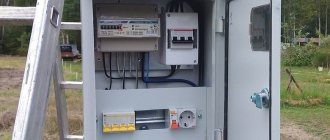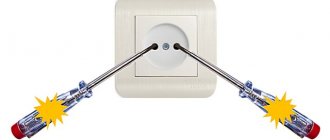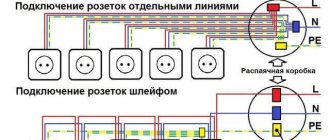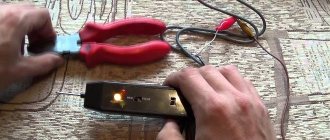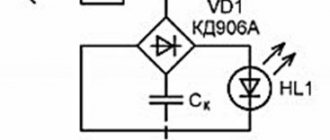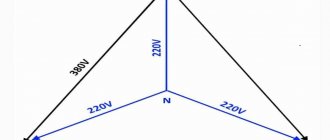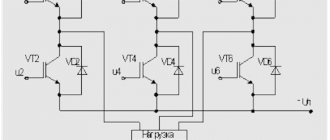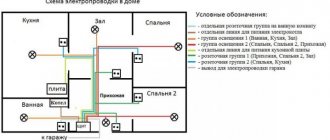Among the arsenal of tools of any home craftsman there is always an indicator screwdriver, which is used to determine the phase potential in home wiring.
Its simple design, simple operation and low cost make it popular.
This indicator works clearly, allows you to see the phase potential, uses the principle of active current flowing through the human body and a built-in neon light bulb.
The rules for its use are described in the article on checking voltage.
When working as an indicator, we are accustomed to the fact that the light on the phase contact of the socket is on, and on the zero contact it is off. We consider this to be the norm in our minds. Moreover, we clearly understand that if the phase wire breaks, there will be no glow and we should look for the fault.
The integrity of the zero potential on the socket is rarely checked, and another technology is required, for example, continuity testing of the electrical circuit.
When, in a single-phase home wiring, the indicator shows a phase on both contacts of the socket, the inexperienced electrician begins to think that there are two of them and asks the question: “Where did the second one come from?”
At the same time, he makes a mistake twice:
- approximately 90%;
- the remaining 10%.
In the first case, we assume that inside a single-phase network there is nowhere for an extraneous phase to appear and a completely different fault has arisen. And in the second, we will still consider the option of the appearance of extraneous potential.
Where does zero break occur?
It is fundamentally important that a zero break can occur in three-phase or single-phase networks.
Completely different processes take place there; I’ll go into detail below. In short, what happens:
When the zero is broken in a three-phase network, a phase imbalance appears, which can lead to the voltage in the apartment outlet increasing to 380 V! For a person, if grounding is performed correctly, such an accident is not dangerous. But for our electrical appliances, the consequences can be very sad! And also for our home, since a fire may occur.
The location of the zero break may be a floor panel, then only apartments on one landing are in the risk zone. Or maybe it’s the input switchgear of a multi-storey building. For example, this:
The input switchgear (RU) in the basement of a multi-storey building is in poor condition
If the zero in a single-phase network breaks, the consequences are not so sad - the voltage in the outlet will be zero, and electrical appliances simply will not work. However, the entire electrical network (and if the grounding is incorrect, even the housing of electrical appliances!) will be at a potential of 220 V!
To begin with, to create fear -
Parallel circuit
With a parallel connection, the phase and neutral conductors simultaneously reach all consumers in the circuit. Let's draw a diagram where these consumers are ordinary incandescent light bulbs.
The input voltage is 220V. With this connection, the voltage on each light bulb will be the same, and with a sufficient cross-section of conductors and a low load, it will not differ much from the input one.
In this case, turning off or turning on each light bulb in turn will not greatly affect its values. It is according to this scheme that all sockets in your apartments are connected.
However, if the voltage is the same, the current in the circuit will be different. Its total value is the sum of the currents passing through bulb No. 1 and No. 2.
You can turn on more powerful devices (200W lamps, kettle), and everything will work perfectly.
Consequences of a zero break in a three-phase network
I'll tell you stories from my life.
- Electricians were repairing the entrance to the entrance. And during the repair, the working zero was turned off for a few seconds. A very unpleasant thing happened: when people returned home in the evening, they discovered that their TVs, refrigerators, chargers, etc. had burned out. - something that is constantly plugged into our outlets. It's good that there hasn't been a fire yet.
- Came on call, complained - tension was floating. I measure the voltage (everything is turned off) - almost 300 volts. Then, when the incandescent lamp is turned on, the voltage drops to 70V... It turned out that a bolt had burnt out in the floor panel, which received a zero. There was a break in the zero, a phase imbalance, and voltages went wild. I replaced the bolt, restored contact, and the voltage returned to normal.
Scratch bolt. Rusty, periodically does not contact!!! If you change it without turning it off, 100% of the equipment in the entrance will burn out!
An article on how I changed the electrical panel there is here.
- I was called to an advertising and publishing company. According to preliminary estimates, the damage is more than 100 thousand rubles, and all due to poor contact on the zero bus:
Zero burnout from the zero bus
The neutral wire burned off from the second bolt. You can see how it fell off under tension. Before falling off, it ALMOST melted the insulation of the phase wires (vertical, red and white).
The server has not been turned on yet, perhaps the intellectual damage will be greater...
At the site of this tragedy, I installed a three-phase voltage relay Barrier, read the article at the link.
As you can see, such problems occur due to incorrect actions of “electricians” or due to spontaneous breakage (burnout) of the neutral wire in the old housing stock.
In this article I will tell you in detail why this happens and how to deal with it.
Breakage of the neutral wire in the junction box or in the wall
Sometimes a zero break occurs in the junction box.
In this case, part of the apartment's wiring is functioning normally, but the line connected to this box is inoperative. It is enough to find where the zero broke off or burned out and restore the connection. It happens that two phases appear in the plug connector due to damage to the neutral wire inside the wall. The cause of the malfunction is negligence when drilling holes. If you break the insulation by breaking through the wire, the neutral conductor will be welded to the phase conductor. In this case, there will also be two phases in the outlet. It is necessary to lay a new line or open the damaged area and repair the wiring.
Formation of single-phase and three-phase networks and zero break
A little theory.
As you know, powerful consumers (in this case, apartment buildings) are powered by a three-phase network, in which there are three phases and zero. I already wrote about this system in detail in an article about the differences between three-phase power supply and single-phase power supply, here is a picture from there:
Voltages in a three-phase system
Let's look at this issue again, only from the other side.
This is what a simplified diagram of the power supply to the floor panel looks like:
Power supply system, without zero break. Three apartments are designated by resistors.
Phase wires L1, L2, L3, on which there is a voltage of 220V in relation to the neutral wire N, are marked in red because they pose a danger. The PE grounding is shown below; its wire is connected in the switchgear at the entrance to the building with the neutral.
For more details, I once again urge you to read my article about grounding systems, link at the beginning.
A brief excursion into theory
When voltage is applied to a household consumer, an electric current flows through it in a closed circuit. If the circuit is open, for example, by a chandelier switch embedded in a phase wire, then there will be no glow.
In this situation, the phase potential reaches the switch, and the zero potential reaches the near contact of the base on each light bulb.
Their wires are briefly called phase and neutral. After turning on the switch, the phase potential reaches the remote contact of the light bulb and a current is formed through the resistance of the filament, which flows through the wires of a closed chain from the source of the supply transformer substation.
If you check the voltage at the remote contact of a light bulb socket with an indicator, it will indicate the phase by its glow, but there will be no glow at the near one. We conclude that the potential here is zero. Now let's look at another option.
What does zero burnout lead to in a three-phase network?
What will change if the neutral wire N breaks BEFORE the junction of the neutral wires at one point? There will be a zero break in a three-phase network:
Zero break in a three-phase network
If you look at the diagram, to the right of the break point the voltage will now not be zero, but “walk” within arbitrary limits.
What happens if the zero is disconnected (accidentally or intentionally)? What voltages will be supplied to consumers instead of 220V? It depends.
The picture in a different form may be easier to understand:
Phase imbalance as a result of zero loss.
Consumers are conventionally shown as resistances R1, R2, R3. The voltages indicated in the previous figure as ~220V are designated as ~0...380V. I'll explain why.
So, what happens if the zero disappears (the cross in the lower right corner)? In an ideal case, when the electrical resistance of all consumers is the same, nothing will change at all. That is, there will be no phase imbalance. This happens when three-phase consumers are turned on, for example, electric motors or powerful air heaters.
But in real life this never happens. There is no one in one apartment, and only the TV is on in standby mode and the phone is charging. And the neighbors on the site did the laundry, turned on the split system and electric kettle. And then - BANG! - the zero burns out.
Phase imbalance begins . And how brutal it is depends on the real situation.
For neighbors who are at home, the kettle will stop heating, the washing machine and splitter will go out, and the voltage will drop to 50...100V. Because the “resistance” of these neighbors is much lower than that of those who are not at home. And so, these people are quietly working at work, and at this time in their empty apartment their TV and Chinese charger are smoking. Because the voltage in the sockets jumped to 300...350V.
These are real facts and figures, this sometimes happens, the condition of electrical panels on staircases is often disastrous. Even when a major renovation is carried out in the house, the panels are not touched, since changing the electrical system is much more difficult than painting the house and installing new windows.
Such a fire should be investigated not by calling psychics (you never know, a poltergeist is playing with matches;)), but by calling an electrician.
Now - about
From theory to practice
If the light went out in one of the rooms, the circuit breaker did not work, i.e. there was no short circuit, you need to take a probe and see what is happening in the sockets or switches, and if two phases are observed there, then you need to look for a zero break.
Reasons for missing zero
Zero can disappear for many reasons, the most common are listed below:
- The old wiring could not withstand the load from modern electrical appliances. This is especially true for apartments where there are still traffic jams, and not modern electrical panels with circuit breakers and zero buses. If, for example, only the zero plug is knocked out, then the appearance of two phases in the sockets is guaranteed;
- A short, small circuit leading to an open circuit. In this case, the circuit breaker may not react (as in our situation).
- Oxidation and burning of contacts (as a result of the same short circuit) at the joints;
- Electrochemical corrosion of copper and aluminum wires. For example, there may be such a situation, a copper neutral wire comes from the shield, and an aluminum one already approaches the socket. Considering that the wires can go directly into the room bypassing the junction box, we can assume that they are connected somewhere in the wall. If they are connected incorrectly, the contact between them could disappear, which will lead to a break in the zero;
- Repair work without taking into account the location of wires in the apartment. Such work is unacceptable. Any drilling in the wall can lead to a break in both the neutral and phase wires, so it is important to use hidden wiring detectors to roughly draw up a diagram of its location.
- Other reasons, for example, rodents chewing wires in old houses, etc.
Places where a zero can burn out
A zero can burn out on any segment, starting from the main panel on the site and ending directly with the outlet. But if the problem occurs on the site (common corridor), then, as a rule, the light will go out in the entire apartment.
And if the common main neutral wire that connects all the apartments on the site and goes into the shaft burns out, then a sharp increase in voltage in the apartment is possible, up to 380V, as a result of which all electrical appliances will burn out. That is why, more and more often, automatic switchboards are being installed in common electrical switchboards, which protect the network from overloads.
But if the apartment has a panel with package switches and a zero bus, and two phases in the sockets are observed only in separate rooms, then the problem must be looked for on the line for which a certain package is responsible.
Zero break in a single-phase network
Here the picture will be as follows:
Zero break in a single-phase network
For a load that operates on other phases, nothing will change at all. It’s the same as if you turn off the automatic circuit breakers in your apartment – your neighbors won’t give a damn.
But if a break occurs, for example, in a panel, then the entire apartment, including the broken end of the neutral wire, will be under 220V voltage!
Breakage (burnout) happens because of rusty bolts like those at the top of this photo:
Bad zero. Missing zero in the apartment
I repeat - if the grounding is done correctly, or if there is no grounding at all, this accident is not dangerous in any way. And, of course, you don’t need to touch the wires without waiting for an electrician - all have deadly potential!
Okay, we understand who is to blame. What to do?
The zero in the socket is missing - we explain point by point
One of the popular electrical wiring faults in an apartment is the appearance of the so-called second phase in the outlet. If the light in the rooms goes out, but all the appliances are working, then you too have become a victim of such a breakdown. Next, we will tell you what to do if there are two phases in the outlet, why this can happen and how to fix the damage yourself!
How to protect yourself from zero loss?
The best protection against zero loss in a three-phase network is a voltage relay, which I have written about on the blog more than once. Here are my two main articles - About the Barrier voltage relay and the EuroAutomatika FiF voltage relay.
Because of its main function, this relay is also called Zero Break Relay.
Another option is to use a voltage stabilizer. It must have protection against low and high (up to 380V) input voltage. And if it is impossible to stabilize the voltage, it must turn off the apartment, but remain operational.
The best option for protection against zero loss and generally unstable voltage is to use a voltage relay, followed by a stabilizer.
How can two phases appear in a regular outlet?
Both meters will remain connected via the neutral wire, but there will be no zero. The situation will be aggravated by the fact that the meters are powered by different phases to ensure uniform loading of the transformer. It turns out that one phase from the first meter will pass through the voltage winding and collide with another phase from the second meter, which also passed through the voltage winding. There will be no short circuit, because... two series-connected voltage windings operating at a voltage of 220 V will be powered from 380 V, i.e. each winding will have 190 V. This is even less than what is stated as acceptable for the windings. For the consumer, it will turn out that on one wire there will be a potential of 220 V, and on the second wire a potential of 190 V. And it seems that everything is also not bad, because at first glance, the voltage in the apartment will be equal to 220 - 190 = 30 V, but this is not so.
Depending on the load, the zero point will shift to a more loaded consumer and instead of 220 V, he will receive significantly less, for example, 100 V less, i.e. 120 V, but his neighbor will receive 380 - 120 = 260 V. If one consumer is is not loaded at all, then it will receive all 380 V into its system. This does not mean that you need to start all the devices to prevent distortion. A zero break is an emergency and is rare.
The literature often describes a phase shift, in which, due to phase asymmetry, the point of zero potential shifts and instead of zero, 5-10 V will hang on the wire relative to the ground wire. In principle, this is normal. It is impossible to connect evenly many single-phase consumers so that the load is perfectly symmetrical. Personally, I measured the current in the grounding wire from the high-voltage transformer to the grounding conductors and it was 4 A. Phase unevenness itself is the norm.
As an experiment, you can take two transformers and connect them in series between two phases. The wire from the midpoint of both transformers must first be connected to the neutral wire. You need to check the voltage on the transformers. The voltage should be 220 V. If you disconnect the neutral wire and measure the voltages on the transformers, then this will be the trick - the voltages will differ if the loads on the transformers are different, or if the powers of the transformers are different, because The resistance of the primary windings will be different.
The results of the experiment are as follows: a zero break causes a phase imbalance between all consumers, shifting the zero point depending on the load of these consumers. The greater the load, the less voltage will come to the apartment.
